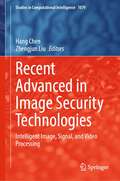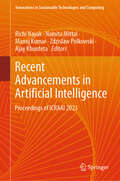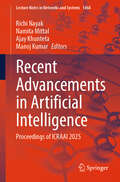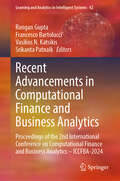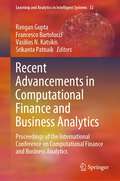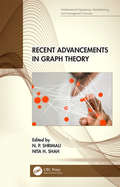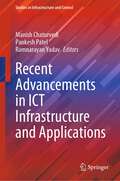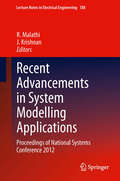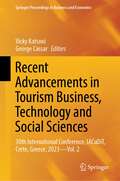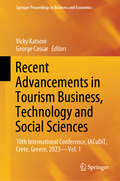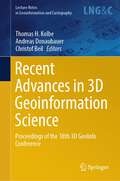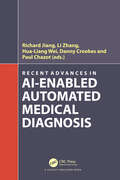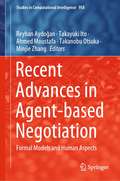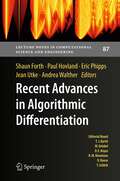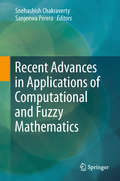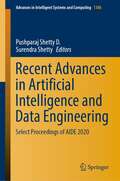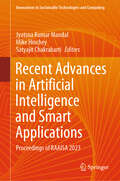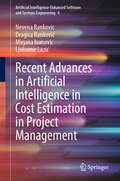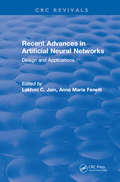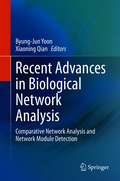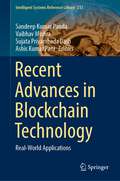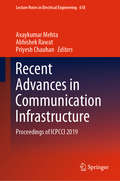- Table View
- List View
Recent Advanced in Image Security Technologies: Intelligent Image, Signal, and Video Processing (Studies in Computational Intelligence #1079)
by Hang Chen Zhengjun LiuThis book provides the readers with a comprehensive overview of principles methodologies and recent advances in image, signal, and video processing using different system. This book is used as the handbook of postgraduates course, such as image processing, signal processing, and optical information security.
Recent Advancements in Artificial Intelligence: Proceedings of ICRAAI 2023 (Innovations in Sustainable Technologies and Computing)
by Manoj Kumar Namita Mittal Zdzislaw Polkowski Richi Nayak Ajay KhuntetaThis book features research papers presented at the Second International Conference on Recent Advancements in Artificial Intelligence (ICRAAI 2023), held at Poornima University, Jaipur, India during 15 – 16 December 2023. The book presents original research work in the areas of computational intelligence, artificial intelligence, machine learning, data science and data analytics, cloud computing, and internet of things. The book is beneficial for readers from both academia and industry.
Recent Advancements in Artificial Intelligence: Proceedings of ICRAAI 2025 (Lecture Notes in Networks and Systems #1468)
by Manoj Kumar Namita Mittal Richi Nayak Ajay KhuntetaThis book contains selected papers presented at Third International Conference on Recent Advancements in Artificial Intelligence ( ICRAAI-2025), organized by the Department of Computer Science & Engineering, Faculty of Computer Science & Engineering, Poornima University, Jaipur, Rajasthan, India, during 21-22 February 2025. The topics covered in the book are the cutting-edge research involved in Artificial Intelligence, Machine Learning, Deep Learning, NLP, and Data Science.
Recent Advancements in Computational Finance and Business Analytics: Proceedings of the 2nd International Conference on Computational Finance and Business Analytics – ICCFBA-2024 (Learning and Analytics in Intelligent Systems #42)
by Srikanta Patnaik Francesco Bartolucci Rangan Gupta Vasilios N. KatsikisThis book presents the latest breakthroughs and cutting-edge advancements within this rapidly evolving field. By providing computational finance and business analytics, organizations can secure a competitive advantage in today’s data-driven and cutting-edge business landscape. This book explores the most recent innovations and significant developments in both the domains of computational finance and business analytics, offering a thorough overview of the current landscape. It encompasses various dimensions including: Business Analytics Financial Analytics HR & Marketing Analytics By integrating the latest theoretical insights with practical applications, this book equips researchers, practitioners, and students with the knowledge and tools necessary to explore and progress in the ever-changing realm of computational finance and business analytics. As the present organizations confront the challenges and adapt the opportunities presented by the data revolution, this book serves as an essential guide, illuminating the transformative frontiers where computational finance and business analytics are redefining the realm of possibilities.
Recent Advancements in Computational Finance and Business Analytics: Proceedings of the International Conference on Computational Finance and Business Analytics (Learning and Analytics in Intelligent Systems #32)
by Srikanta Patnaik Francesco Bartolucci Rangan Gupta Vasilios N. KatsikisRecent Advancements of Computational Finance and Business Analytics provide a comprehensive overview of the cutting-edge advancements in this dynamic field. By embracing computational finance and business analytics, organizations can gain a competitive edge in an increasingly data-driven and complex business environment.This book has explored the latest developments and breakthroughs in this rapidly evolving domain, providing a comprehensive overview of the current state of computational finance and business analytics. It covers the following dimensions of this domains:Business AnalyticsFinancial AnalyticsHuman Resource AnalyticsMarketing Analytics
Recent Advancements in Graph Theory (Mathematical Engineering, Manufacturing, and Management Sciences)
by N. P. Shrimali and Nita H. ShahGraph Theory is a branch of discrete mathematics. It has many applications to many different areas of Science and Engineering. This book provides the most up-to-date research findings and applications in Graph Theory. This book focuses on the latest research in Graph Theory. It provides recent findings that are occurring in the field, offers insights on an international and transnational levels, identifies the gaps in the results, and includes forthcoming international studies and research, along with its applications in Networking, Computer Science, Chemistry, and Biological Sciences, etc. The book is written with researchers and post graduate students in mind.
Recent Advancements in ICT Infrastructure and Applications (Studies in Infrastructure and Control)
by Manish Chaturvedi Pankesh Patel Ramnarayan YadavThis book covers complete spectrum of the ICT infrastructure elements required to design, develop and deploy the ICT applications at large scale. Considering the focus of governments worldwide to develop smart cities with zero environmental footprint, the book is timely and enlightens the way forward to achieve the goal by addressing the technological aspects. In particular, the book provides an in depth discussion of the sensing infrastructure, communication protocols, computation frameworks, storage architectures, software frameworks, and data analytics. The book also presents the ICT application-related case studies in the domain of transportation, health care, energy, and disaster management, to name a few. The book is used as a reference for design, development, and large-scale deployment of ICT applications by practitioners, professionals, government officials, and engineering students.
Recent Advancements in System Modelling Applications
by J Krishnan R MalathiThe book is a collection of peer-reviewed scientific papers submitted by active researchers in the 36th National System Conference (NSC 2012). NSC is an annual event of the Systems Society of India (SSI), primarily oriented to strengthen the systems movement and its applications for the welfare of humanity. A galaxy of academicians, professionals, scientists, statesman and researchers from different parts of the country and abroad are invited to attend the Conference. The book presents various research articles in the area of system modelling in all disciplines of engineering sciences as well as socio-economic systems. The book can be used as a tool for further research.
Recent Advancements in Tourism Business, Technology and Social Sciences: 10th International Conference, IACuDiT, Crete, Greece, 2023 - Vol. 2 (Springer Proceedings in Business and Economics)
by Vicky Katsoni George CassarThe book features the second volume of the proceedings of the 10th International Conference of the International Association of Cultural and Digital Tourism (IACuDiT), with the theme “Recent Advancements in Tourism Business, Technology, and Social Sciences,” which was held from August 29 to 31, 2023, in Crete, Greece. It showcases the latest research on Tourism Business, Technology, and Social Sciences and presents a critical academic discourse on smart and sustainable practices in the tourism industry, stimulating future debates and advancing readers’ knowledge and understanding of this critical area of tourism business in the post-COVID-19 era. COVID-19 produced dramatic effects on the global economy, business activities, and people, with tourism being particularly affected. The book discusses the resulting digital transformation process in a range of areas, including its effect on the social sciences combined with special forms of tourism. This accelerated digitalizationencourages the emergence of new digital products and services based on the principle of flexibility. The book focuses on the knowledge economy and smart destinations, as well as new modes of tourism management and development, and includes chapters on emerging technologies such as the Internet of Things, artificial intelligence, big data, and robotics in connection with various tourism practices.
Recent Advancements in Tourism Business, Technology and Social Sciences: 10th International Conference, IACuDiT, Crete, Greece, 2023—Vol. 1 (Springer Proceedings in Business and Economics)
by Vicky Katsoni George CassarThe book features the first volume of the proceedings of the 10th International Conference of the International Association of Cultural and Digital Tourism (IACuDiT), with the theme “Recent Advancements in Tourism Business, Technology, and Social Sciences,” which was held from August 29 to 31, 2023, in Crete, Greece. It showcases the latest research on Tourism Business, Technology, and Social Sciences and presents a critical academic discourse on smart and sustainable practices in the tourism industry, stimulating future debates and advancing readers’ knowledge and understanding of this critical area of tourism business in the post-COVID-19 era. COVID-19 produced dramatic effects on the global economy, business activities, and people, with tourism being particularly affected. The book discusses the resulting digital transformation process in a range of areas, including its effect on the social sciences combined with special forms of tourism. This accelerated digitalization encourages the emergence of new digital products and services based on the principle of flexibility. The book focuses on the knowledge economy and smart destinations, as well as new modes of tourism management and development, and includes chapters on emerging technologies such as the Internet of Things, artificial intelligence, big data, and robotics in connection with various tourism practices.
Recent Advances in 3D Geoinformation Science: Proceedings of the 18th 3D GeoInfo Conference (Lecture Notes in Geoinformation and Cartography)
by Thomas H. Kolbe Andreas Donaubauer Christof BeilThe book includes the contributions to the international conference “18th 3D GeoInfo”. The papers published in the book were selected through a double-blind review process. 3D GeoInfo has been the forum joining researchers, professionals, software developers, and data providers designing and developing innovative concepts, tools, and application related to 3D geo data processing, modeling, management, analytics, and simulation. A big focus is on topics related to data modeling for 3D city and landscape models as well as their many and diverse applications. This conference series is very successfully running since 2006 and has been hosted by countries in Europe, Asia, Africa, North America, and Australia. In the period 2006 to 2017, the proceedings has been published by Springer in this series with Thomas H. Kolbe being the editor of the 2010 edition of the conference proceedings. 18th 3DGeoInfo was organized by Technical University of Munich in cooperation with the German Society for Photogrammetry, Remote Sensing and Geoinformation (DGPF), the local associations Runder Tisch GIS e.V. (Round Table GIS) and Leonhard Obermeyer Center—TUM Center of Digital Methods for the Built Environment, and the City of Munich. The international program committee consisted of committee members of previous 3D GeoInfo conferences and further leading scientists in the field of 3D Geoinformation Science.
Recent Advances in AI-enabled Automated Medical Diagnosis
by Li Zhang Richard Jiang Danny Crookes Hua-Liang Wei Paul ChazotDevelopments in deep learning in the past decade have led to phenomenal growth in AI-based automated medical diagnosis, opening a door to a new era of both medical research and medical industry. It is a golden age for researchers involved in the development and application of advanced machine learning techniques for medical and clinical problems. This book captures the most recent important advances in this cross-disciplinary topic and brings the latest advances to a wide audience including experts, researchers, students, industry developers and medical services.
Recent Advances in Agent-Based Negotiation: Applications and Competition Challenges (Studies in Computational Intelligence #1092)
by Takayuki Ito Rafik Hadfi Reyhan Aydoğan Ryuta ArisakaThis book comprises carefully selected and reviewed outcomes of the 13th International Workshop on Automated Negotiations (ACAN) held in Vienna, 2022, in conjunction with International Joint Conference on Artificial Intelligence (IJCAI) 2022. It focuses on the applications and challenges of agent-based negotiation including agreement technology, mechanism design, electronic commerce, recommender systems, supply chain management, social choice theory, and others. This book is intended for the academic and industrial researchers of various communities of autonomous agents and multi-agent systems, as well as graduate students studying in those areas or having interest in them.
Recent Advances in Agent-based Complex Automated Negotiation
by Minjie Zhang Takayuki Ito Katsuhide Fujita Valentin Robu Naoki FukutaThis bookcovers recent advances in Complex Automated Negotiations as a widely studiedemerging area in the field of Autonomous Agents and Multi-Agent Systems. The book includes selectedrevised and extended papers from the 7th International Workshop on Agent-Based ComplexAutomated Negotiation (ACAN2014), which was held in Paris, France, in May2014. The book also includes brief introductions aboutAgent-based Complex Automated Negotiation which are based on tutorials providedin the workshop, and brief summaries and descriptions about the ANAC'14 (AutomatedNegotiating Agents Competition) competition, where authors of selectedfinalist agents explain the strategies and the ideas used by them. Thebook is targeted to academic and industrial researchers in various communitiesof autonomous agents and multi-agent systems, such as agreement technology,mechanism design, electronic commerce, related areas, as well as graduate,undergraduate, and PhD students working in those areas or having interest inthem.
Recent Advances in Agent-based Negotiation: Formal Models and Human Aspects (Studies in Computational Intelligence #958)
by Minjie Zhang Takayuki Ito Reyhan Aydoğan Ahmed Moustafa Takanobu OtsukaThis volume comprises carefully selected and reviewed outcomes of the 12th International Workshop on Automated Negotiations (ACAN) held in Macao, 2019, in conjunction with International Joint Conference on Artificial Intelligence (IJCAI) 2019. It focuses on human aspects of automated negotiation and the recent advances in negotiation frameworks and strategies. Written by leading academic and industrial researchers, it is a valuable resource for professionals and scholars working on complex automated negotiations.
Recent Advances in Algorithmic Differentiation
by Andrea Walther Eric Phipps Jean Utke Paul Hovland Shaun ForthThe proceedings represent the state of knowledge in the area of algorithmic differentiation (AD). The 31 contributed papers presented at the AD2012 conference cover the application of AD to many areas in science and engineering as well as aspects of AD theory and its implementation in tools. For all papers the referees, selected from the program committee and the greater community, as well as the editors have emphasized accessibility of the presented ideas also to non-AD experts. In the AD tools arena new implementations are introduced covering, for example, Java and graphical modeling environments or join the set of existing tools for Fortran. New developments in AD algorithms target the efficiency of matrix-operation derivatives, detection and exploitation of sparsity, partial separability, the treatment of nonsmooth functions, and other high-level mathematical aspects of the numerical computations to be differentiated. Applications stem from the Earth sciences, nuclear engineering, fluid dynamics, and chemistry, to name just a few. In many cases the applications in a given area of science or engineering share characteristics that require specific approaches to enable AD capabilities or provide an opportunity for efficiency gains in the derivative computation. The description of these characteristics and of the techniques for successfully using AD should make the proceedings a valuable source of information for users of AD tools.
Recent Advances in Applications of Computational and Fuzzy Mathematics
by Snehashish Chakraverty Sanjeewa PereraThis book addresses the basics of interval/fuzzy set theory, artificial neural networks (ANN) and computational methods. It presents step-by-step modeling for application problems along with simulation and numerical solutions. In general, every science and engineering problem is inherently biased by uncertainty, and there is often a need to model, solve and interpret problems in the world of uncertainty. At the same time, exact information about models and parameters of practical applications is usually not known and precise values do not exist. This book discusses uncertainty in both data and models. It consists of seven chapters covering various aspects of fuzzy uncertainty in application problems, such as shallow water wave equations, static structural problems, robotics, radon diffusion in soil, risk of invasive alien species and air quality quantification. These problems are handled by means of advanced computational and fuzzy theory along with machine intelligence when the uncertainties involved are fuzzy. The proposed computational methods offer new fuzzy computing methods that help other areas of knowledge construction where inexact information is present.
Recent Advances in Artificial Intelligence and Data Engineering: Select Proceedings of AIDE 2020 (Advances in Intelligent Systems and Computing #1386)
by Pushparaj Shetty D. Surendra ShettyThis book presents select proceedings of the International Conference on Artificial Intelligence and Data Engineering (AIDE 2020). Various topics covered in this book include deep learning, neural networks, machine learning, computational intelligence, cognitive computing, fuzzy logic, expert systems, brain-machine interfaces, ant colony optimization, natural language processing, bioinformatics and computational biology, cloud computing, machine vision and robotics, ambient intelligence, intelligent transportation, sensing and sensor networks, big data challenge, data science, high performance computing, data mining and knowledge discovery, and data privacy and security. The book will be a valuable reference for beginners, researchers, and professionals interested in artificial intelligence, robotics and data engineering.
Recent Advances in Artificial Intelligence and Smart Applications: Proceedings of RAAISA 2023 (Innovations in Sustainable Technologies and Computing)
by Mike Hinchey Jyotsna Kumar Mandal Satyajit ChakrabartiThe book includes original unpublished contributions presented in First International Conference on Recent Advances in Artificial Intelligence and Smart Applications (RAAISA 2023), organized by Department of CSE, University of Engineering and Management, Kolkata, India during 14 – 15 December 2023. The topics covered are progression of artificial intelligence techniques like smart agent-based systems, human-computer interaction technologies, reinforcement learning, sentiment analysis, recurrent neural networks and its applications, genetic algorithm, and neural networks.
Recent Advances in Artificial Intelligence and Smart Applications: Proceedings of RAAISA 2024 (Lecture Notes in Networks and Systems #1380)
by Mike Hinchey Satyajit Chakrabarti Jyotsna K. MandalThis book includes original unpublished contributions presented in the Second International Conference on Recent Advances in Artificial Intelligence and Smart Applications (RAAISA 2024), organized by the Department of CSE, University of Engineering and Management, Kolkata, India, during December 14–15, 2024. The topics covered are progression of artificial intelligence techniques like smart agent-based systems, human–computer interaction technologies, reinforcement learning, sentiment analysis, recurrent neural networks and its applications, genetic algorithms, and neural networks.
Recent Advances in Artificial Intelligence in Cost Estimation in Project Management (Artificial Intelligence-Enhanced Software and Systems Engineering #6)
by Mirjana Ivanovic Nevena Rankovic Dragica Ranković Ljubomir LazićThis book focuses on the practical application of AI tools and techniques in software project management, offering detailed theoretical explanations and practical examples of over 40 state-of-the-art machine learning and deep learning algorithms applied across each project phase, as well as in risk and resource management. Helping the business world estimate projects more accurately while saving costs and resources is crucial in today’s rapidly changing, fast-paced technological landscape. Moreover, it presents specific aspects of combined approaches through ensemble models, incorporating Taguchi’s optimization method to further improve estimation accuracy, advancing this area of software project management. A valuable resource for students and professionals to deepen their knowledge and skills, it also serves as a great manual for companies adopting smarter strategies to manage and develop projects more efficiently and effectively.
Recent Advances in Artificial Neural Networks: Design And Applications (International Series On Computational Intelligence Ser.)
by L. C. JainNeural networks represent a new generation of information processing paradigms designed to mimic-in a very limited sense-the human brain. They can learn, recall, and generalize from training data, and with their potential applications limited only by the imaginations of scientists and engineers, they are commanding tremendous popularity and research interest. Over the last four decades, researchers have reported a number of neural network paradigms, however, the newest of these have not appeared in book form-until now. Recent Advances in Artificial Neural Networks collects the latest neural network paradigms and reports on their promising new applications. World-renowned experts discuss the use of neural networks in pattern recognition, color induction, classification, cluster detection, and more. Application engineers, scientists, and research students from all disciplines with an interest in considering neural networks for solving real-world problems will find this collection useful.
Recent Advances in Biological Network Analysis: Comparative Network Analysis and Network Module Detection
by Byung-Jun Yoon Xiaoning QianThis book reviews recent advances in the emerging field of computational network biology with special emphasis on comparative network analysis and network module detection. The chapters in this volume are contributed by leading international researchers in computational network biology and offer in-depth insight on the latest techniques in network alignment, network clustering, and network module detection. Chapters discuss the advantages of the respective techniques and present the current challenges and open problems in the field. Recent Advances in Biological Network Analysis: Comparative Network Analysis and Network Module Detection will serve as a great resource for graduate students, academics, and researchers who are currently working in areas relevant to computational network biology or wish to learn more about the field. Data scientists whose work involves the analysis of graphs, networks, and other types of data with topological structure or relations can also benefit from the book's insights.
Recent Advances in Blockchain Technology: Real-World Applications (Intelligent Systems Reference Library #237)
by Sandeep Kumar Panda Vaibhav Mishra Sujata Priyambada Dash Ashis Kumar PaniThis book provides insights on blockchain technology and its applications in real-world business, supply chain, health care, education, HRM, retail, logistics and transport industries. This book grants a comprehensive understanding of how this technology is functioning within modern real-world applications and how it can influence the future of the real-world applications in industry. The chapters cover the case study, applications of blockchain, benefits and challenges, disruptive innovations in real-world applications, privacy and security concerns, and the recent trends of blockchain in real-world applications. It is ideally intended for marketers, advertisers, brand managers, executives, managers, IT specialists and consultants, researchers, businesses, practitioners, stakeholders, academicians, and students interested in blockchain technology and its role in supply chain, health care, education, HRM, retail, logistics and transport industries.
Recent Advances in Communication Infrastructure: Proceedings of ICPCCI 2019 (Lecture Notes in Electrical Engineering #618)
by Axaykumar Mehta Abhishek Rawat Priyesh ChauhanThis book gathers selected research papers presented at the International Conference on Power, Control and Communication Infrastructure 2019 (ICPCCI 2019), organized by the Institute of Infrastructure, Technology, Research and Management (IITRAM), Ahmedabad, Gujarat, India, on July 4–5, 2019. It presents technological developments in the fields of communications infrastructure which comprise of architecture, products, and network connections that allow for communications over the long distances. The book includes some innovative ideas in the field of communication infrastructure, specially satellite communication, navigation systems, artificial neural network, encryption techniques, and some other infrastructure-related developments. The solution approaches provided in this book encourage and inspire researchers, industry professionals, and policymakers to put these methods into practice.
